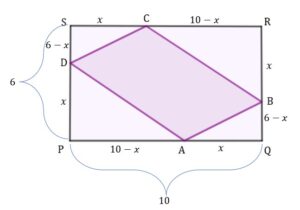Uzupełnijmy nasz rysunek
 |
Funkcja opisująca pole czworokąta jest funkcją kwadratową:
Określmy jej dziedzinę:
Zatem
Wykresem naszej funkcji jest parabola z ramionami skierowanymi ku górze.
Znajdźmy jej wierzchołek
Dla pole czworokąta
będzie najmniejsze i będzie równe
.
Was this helpful?
0 / 0